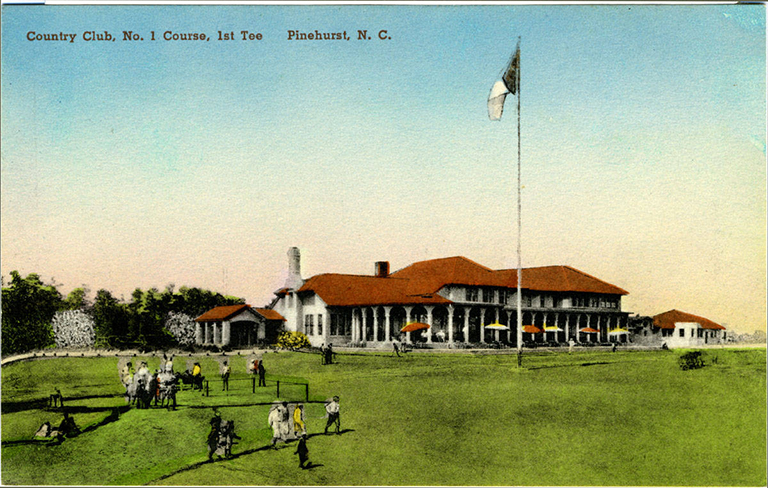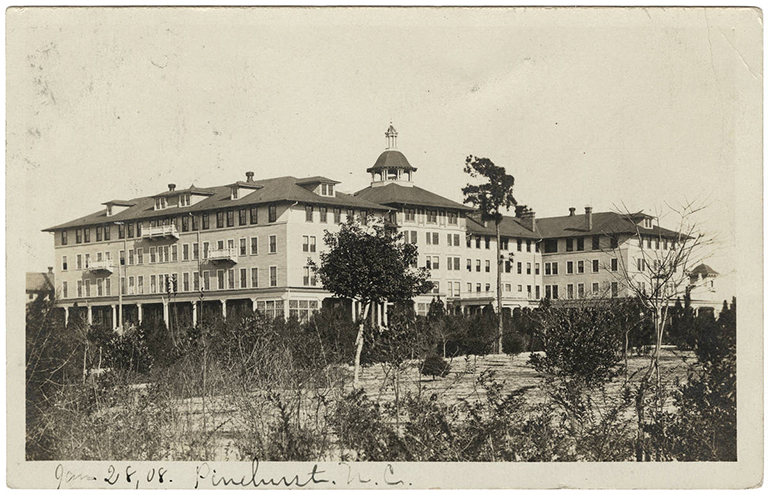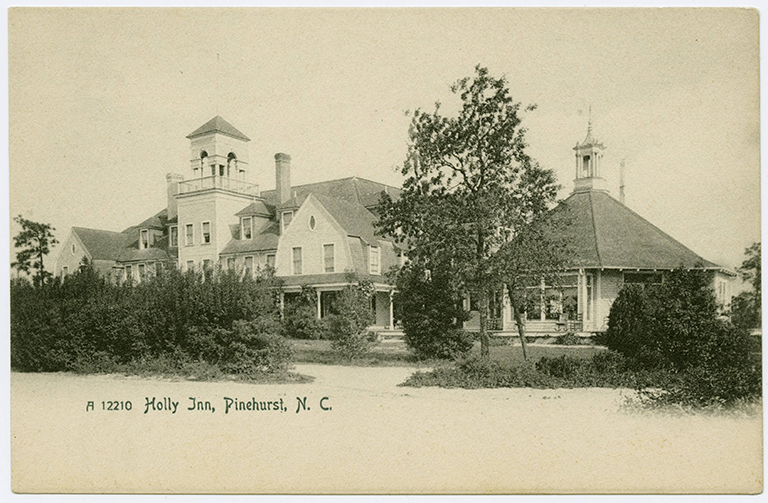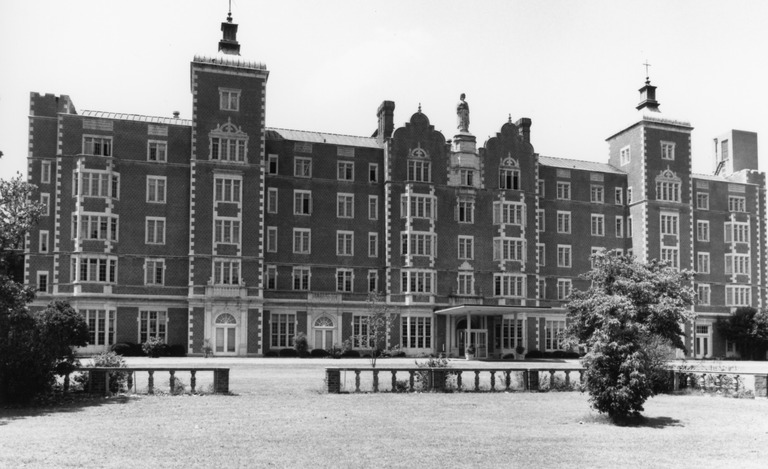Sise, Lyman F. (1862-1943)
Birthplace:
Boston, Massachusetts, USA
Residences:
- Boston, Massachusetts
Trades:
- Architect
NC Work Locations:
Building Types:
Styles & Forms:
Colonial Revival; Tudor Revival
Lyman F. Sise (1862-1943), a native of Massachusetts educated at MIT, practiced architecture in Boston and vicinity and was associated with the firms of Burr and Sise and Haven and Hoyt. Much of these firms’ work was in Boston and vicinity, but they also planned key buildings in the Sand Hills resort community of Pinehurst. Sise and his associates were among a number of Boston architects employed by Pinehurst founder James W. Tufts of Medford and Boston to design the new community’s architecture (see Bertrand E. Taylor). The Pinehurst Outlook of August 1, 1907, recalled that soon after Pinehurst founder Tufts purchased the initial 1,000 acres for Pinehurst in June, 1895, “the work of clearing and building beg[a]n immediately; the original plans for The Holly Inn and many other buildings, being drawn by Mr. Lyman F. Sise, the Medford, Mass., architect.” It was apparently Sise who was most directly involved in the Sand Hills projects for his firms. Sise’s association with Pinehurst was strengthened by his personal connection with Pinehurst founder Tufts and his family: in 1895, at the outset of the development of Pinehurst, James W. Tufts’ only son, Leonard, married Lyman Sise’s sister, Gertrude Ware Sise (1870-1940). Lyman, Gertrude, and their brother Lincoln were the children of the wealthy and socially prominent Albert Fleetwood Sise and Edith Ware of Massachusetts. In 1890, Lyman Sise had married Ann Mason Fowler of an old New England family, and the couple had four children. He died in West Medford, Massachusetts. James W. Tufts had also resided in Medford.
Sise’s first major project in Pinehurst, as noted, was the picturesque, frame Holly Inn (1895 and later), built for Tufts as the community’s first hotel. At that time Sise was part of the firm of Burr and Sise with architect Horace F. Burr (1844-1900), a native of Maine and a Union veteran who practiced architecture in Boston for many years. Burr had worked in the renowned office of Peabody and Stearns before forming a partnership with Sise. Besides the hotel, Sise also planned a number of cottages in Pinehurst.
After James W. Tufts’ sudden death in 1902, Pinehurst continued to grow under the leadership of Leonard Tufts, and included Sise’s additions to the existing Carolina Hotel designed by Bertrand E. Taylor. Sise’s commissions in the area demonstrate the range of romantic and eclectic styles popular at the time. Best known is the famed Pinehurst Country Club (1922), designed in a Mediterranean spirit during his association with the Boston firm of Haven and Hoyt. The principals in this firm were Parker B. Haven (1858-1943) and Edward A. Hoyt (1868-1936). Beginning in the 1880s, Parker B. Haven had practiced for several years with Edmund L. Wheelwright as a partner in the firm of Wheelwright and Haven. Edward A. Hoyt, a native of New Hampshire trained in the offices of Peabody and Stearns, worked as a draftsman and architect with Wheelwright and Haven, and after Wheelwright’s death in 1912, Hoyt joined Haven in a partnership that continued for more than twenty years. Lyman Sise worked with the firm for several years. A final major project in the Pinehurst area is credited to Sise alone—the towering, Jacobean or Tudor Revival style Pine Needles Inn (1927) in Knollwood Heights. The Tufts Archives in Pinehurst includes a large collection of architectural records for buildings by Lyman Sise, Haven and Hoyt, and other architects active in the community, from which additional citations and information may be obtained.
- Catherine W. Bishir and Michael T. Southern, A Guide to the Historic Architecture of Piedmont North Carolina (2003).
- Linda Harris Edmisten, “Pinehurst Race Track,” National Register of Historic Places nomination (1977).
- Davyd Foard Hood and Laura A. W. Phillips, Pinehurst Historic District National Historic Landmark Designation Report (1995).
- Tufts Archives, Given Memorial Library, Pinehurst, North Carolina.
- Henry F. Withey and Elsie Rathburn Withey, Biographical Dictionary of American Architects (Deceased) (1970).
Carolina Hotel
Contributors:William Carter Bain, contractor; Hoyt and Haven, architects (1914); Kendall, Taylor and Stevens, architects; Lyman F. Sise, architect (1914); Bertrand E. Taylor, architectDates:1899-1900; 1914 (addition)
Location:Pinehurst, Moore CountyStreet Address:Midpines Rd., Pinehurst, NC
Status:Standing
Type:Commercial
Images Published In:Catherine W. Bishir and Michael T. Southern, A Guide to the Historic Architecture of Piedmont North Carolina (2003).
Note:As his Sand Hills resort community of Pinehurst succeeded, founder James W. Tufts of Boston hired Kendall, Taylor, and Stevens to plan the imposing, 4-story Colonial Revival style Carolina Hotel. Its 350 rooms exceeded the previously built boarding houses and inns in town. Expanded and updated over the years, it maintains its character and stature.
Cedarcrest
Contributors:Lyman F. Sise, architectDates:1916
Location:Pinehurst, Moore CountyStreet Address:225 Beulah Hill Rd., Pinehurst, NC
Status:Altered
Type:Residential
Note:The frame residence, altered over the years, was built for steamship magnate James Barber on property he purchased in 1916. Within a few years he moved to a new house across the road, known as Thistle Dew.
Cotton Cottage
Contributors:Lyman F. Sise, architectDates:1916-1917
Location:Southern Pines, Moore CountyStreet Address:315 Beulah Hill Rd., Southern Pines, NC
Status:Standing
Type:Residential
Note:The Pinehurst Outlook in 1916 cited Sise as architect for the frame house with its strongly composed façade; weatherboarded now, it was originally covered in wood shingles.
Holly Inn
Contributors:Burr and Sise, architects (1895); Hoyt and Haven, architects (1925); Rand and Taylor, architects (1900s); Lyman F. Sise, architect (1895, 1925)Dates:1895 and later
Location:Pinehurst, Moore CountyStreet Address:Cherokee Rd., Pinehurst, NC
Status:Altered
Type:Commercial
Note:The first hotel built in Pinehurst, the Holly Inn was constructed as a 2-story frame building in Colonial Revival style. In 1925 Haven and Hoyt and Lyman Sise altered the façade, removing the original central tower and adding neoclassical elements. Further expansions occurred over the years.
Pine Needles Inn
Contributors:Lyman F. Sise, architectVariant Name(s):St. Josephs Hospital
Dates:1927
Location:Pinehurst, Moore CountyStreet Address:Central Drive, Pinehurst vicinity, NC
Status:Standing
Type:Commercial
Note:Built as a large resort hotel, the edifice was converted to a hospital in 1948.
Pinehurst Country Club
Contributors:Hoyt and Haven, architects; Lyman F. Sise, architectDates:1922
Location:Pinehurst, Moore CountyStreet Address:Carolina Vista Rd., Pinehurst, NC
Status:Standing
Type:Recreational
Images Published In:Catherine W. Bishir and Michael T. Southern, A Guide to the Historic Architecture of Piedmont North Carolina (2003).
Note:A beloved landmark of the Sand Hills golfing mecca, the Pinehurst Country Club is a capacious and picturesque building of concrete and tile, designed in a hospitable Mediterrannean style with arcaded porches overlooking the golf courses. Here is the nationally renowned Pinehurst No. 2 Course (1901, 1935) planned by Donald Ross.
The Fair Barn
Contributors:Lyman F. Sise, architectDates:1917; 1930s
Location:Pinehurst, Moore CountyStreet Address:Pinehurst Harness Track, Pinehurst, NC
Status:Standing
Type:Recreational
Note:The Mission Style structure was planned by Sise for the Tufts family to serve as an exhibition hall for the Sandhills Fair, and it subsequently served as a stable.




